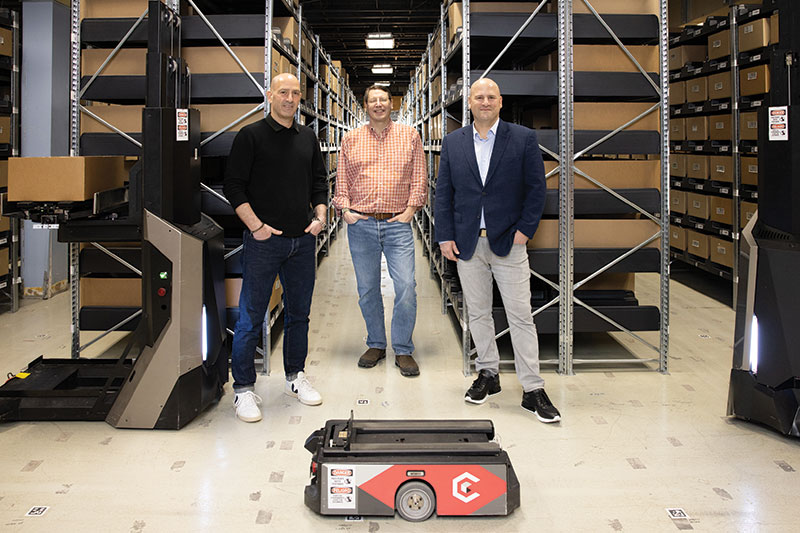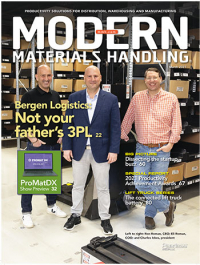Bergen Logistics: Not your father’s 3PL
A New Jersey-based 3PL puts high levels of technology and automation to work in its e-commerce fulfillment operations. The showcase is a robotic solution for storage and goods-to-person picking.
Back in 1988, Oldsmobile—remember that brand?—tried to change its image as a manufacturer of stodgy land cruisers favored by old men in hats with a new sleek design and slogan: “This is Not Your Father’s Oldsmobile. This is the New Generation Oldsmobile.”
And while that didn’t work out so well for GM, which mothballed Oldsmobile in 2004, a similar refresh—this one more successful—is happening in the third-party logistics (3PL) market. 3PLs that once eschewed automation in favor of labor have been pushing hard into the e-commerce fulfillment market. There, speed matters above all.
In reality, you can’t speed up order fulfillment times simply by adding more labor, assuming you can even find it and afford it. Instead, leading 3PLs are embracing high levels of technology and automation, including robotics, automated packaging and other solutions to compete. Innovation is now top of mind. It is lending a new image to an industry that is no longer your father’s 3PL.
Bergen Logistics fits that description. At its flagship North Bergen, N.J., distribution center, a 607,000-square-foot, multi-level and multi-tenant facility, the showcase is a robotic solution that uses two different size robots that work in tandem (Caja Robotics). The larger of the two robots performs automated storage and retrieval tasks.
These lifts retrieve inventory bins from a staging area, reaching up to 15 feet to put them away in storage units, and then retrieve and stage them in lower position slots when they’re required to fill demand. The smaller of the two robots automatically retrieves bins in those pickup slots, delivers them to one of two goods-to-person workstations and then returns the depleted bins to the storage area for putaway again by the larger units. Bergen is currently operating a fleet of five larger units and 20 of the smaller robots with plans to expand the fleet.
But that’s not all. The facility also includes an extensive conveyor and sortation system, including bombay and garment-on-hanger (GOH) sortation, and automated packaging systems. In the innovation category, Bergen Logistics builds its own scanners and developed a Cloud-based warehouse management system (WMS) that it has deployed across a network of six DCs in North America, the Netherlands and Hong Kong to a serve a client base that skews heavily toward fashion apparel.
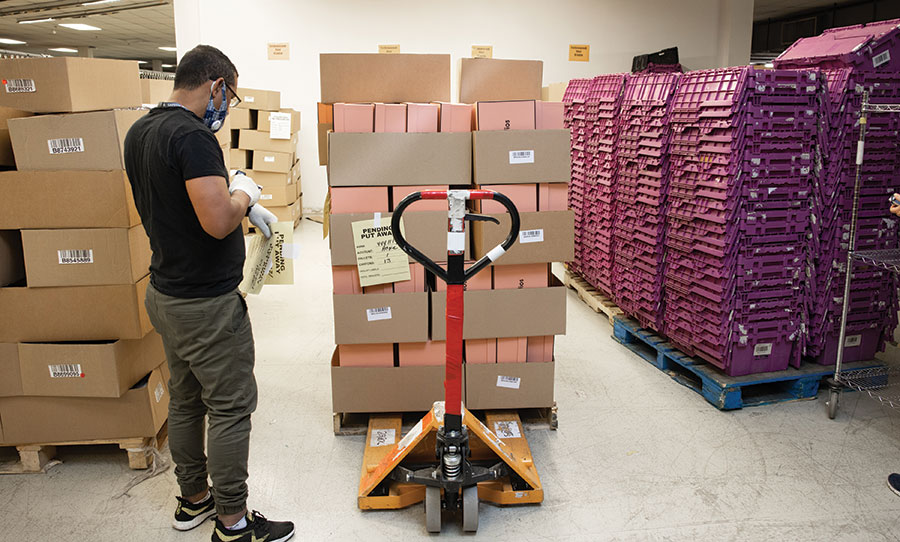
Inventory containers are palletized on the ground level and transported by elevator to the second level for replenishment.
Why technology? “Technology and customer service are what sets us apart,” says Ron Roman, founder and CEO of Bergen Logistics. “And, of course, any automation we choose has to be flexible and adjustable to different products and different types of distribution. That’s why we went with Caja Robotics.”
The journey to automation
Over the past 20 years, Bergen Logistics has grown from providing ship-to-store services from a 2,000-square-foot back office location for one client to servicing about 450 active accounts from about 2 million square feet spread across six locations: three in the United States, one in Canada, one in Hong Kong and one in the Netherlands, with a specialization in fashion apparel, accessories, jewelry, shoes and cosmetics.
Apparel was a natural to Roman. Prior to founding the company, he worked in the fashion industry. “Someone asked me if we could ship product on their behalf, and we launched the business from that small storeroom,” Roman recalls. Back then, everything was manual. New merchandise was unloaded by hand, pick lists and packing slips were printed on a dot matrix printer and shipping information was entered manually into a record book. When that first client sent some garments on hangers, associates installed some pipe on the wall. “That was our first encounter with garment-on-hanger,” Roman recalls.
After that first season, Roman added a second brand to the client list. From there, growth was exponential. So was the scope of services offered. From simple pick and pack for a fashion apparel client, the products handled expanded to include toys, consumer electronics, medical devices and supplements.
The company serves multiple channels, including wholesale distribution, direct-to-consumer and drop ship. In addition, Bergen Logistics offers value-added services, including customization, embroidery and branding to differentiate its clients.
Early on, Roman recognized that technology was going to be a necessity. All of the North American facilities are equipped with garment-on-hanger speed-rail systems and automated conveyor and sortation systems for quick and efficient order processing. An in-house software development team includes 15 technology developers and testers. The 3PL’s proprietary WMS is integrated on the front end with all of the major e-commerce platforms, including Shopify and Magento; international checkout systems such as Passport; and the most commonly used enterprise resource planning (ERP) systems. On the back end, it integrates with the 3PLs materials handling automation systems.
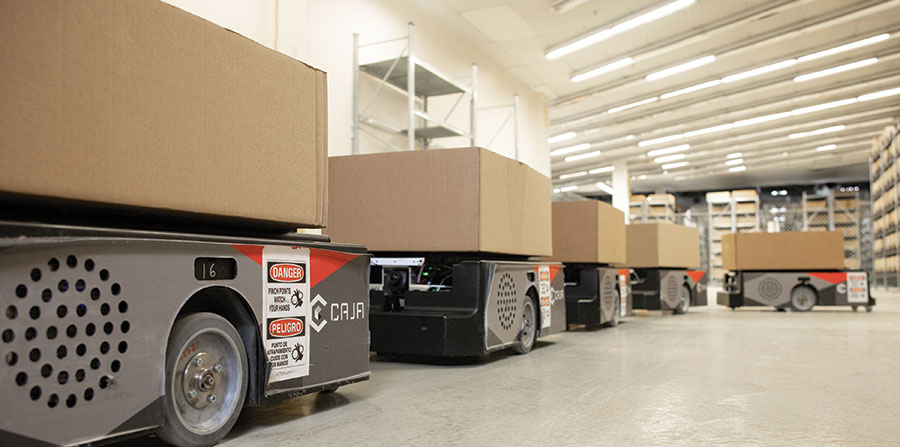
The smaller robot retrieves cartons from the lower storage levels and then delivered to a goods-to-person work station for picking.
“Today, business is digital first,” explains Eli Roman, the company’s chief operating officer. “To compete, we have to be able to provide an amazing solution and full access to everything that’s happening with integration to our customers’ ERP systems, shopping carts, inventory and returns. Everyone wants to see everything now and in real time.”
Adds company president Charles Ickes: “We are one of the only 3PLs that can handle multiple channels of distribution from one bucket of inventory. That allows us to ship 100 orders from one UPC code, each with a different packing slip and packing instructions if required by the customer.”
That also reduces the amount of inventory a client needs to maintain in any one location to service its channels. “The ability to handle all channels from one bucket of inventory is a real competitive advantage,” Ickes says.
The company’s journey from manual to automated has been customer driven. The WMS, for instance, was developed in response to the customer demands for more real-time information. “We had a client with an average of 200,000 units and an inventory that was changing all the time,” Ron Roman recalls. “We’d get a stack of pick tickets 6 inches high at the beginning of the week, and a day or so later, we’d get a question about the status of a specific order for store ABC. We realized we had to start tracking pick tickets.”
The company began working with materials handling automation in 2008, after it purchased the four-level North Bergen location from another fashion retailer. “We had a customer whose business with us kept growing, and eventually units were coming in too fast for us to do everything manually,” Eli Roman says. “We took apart a bombay sorter located on the fourth floor and re-installed it in another location in the building. That significantly increased our productivity.”
In the following years, Bergen Logistics installed more conveyor, other types of sortation, GOH systems and automated packaging solutions. “We look for efficiencies wherever we can find them,” says Ron Roman. “When you look at the increases in the cost of labor, your ROI starts to make sense.” Finally, given the diversity of its customer base and the variety of products handled in the building, automation has to be flexible.
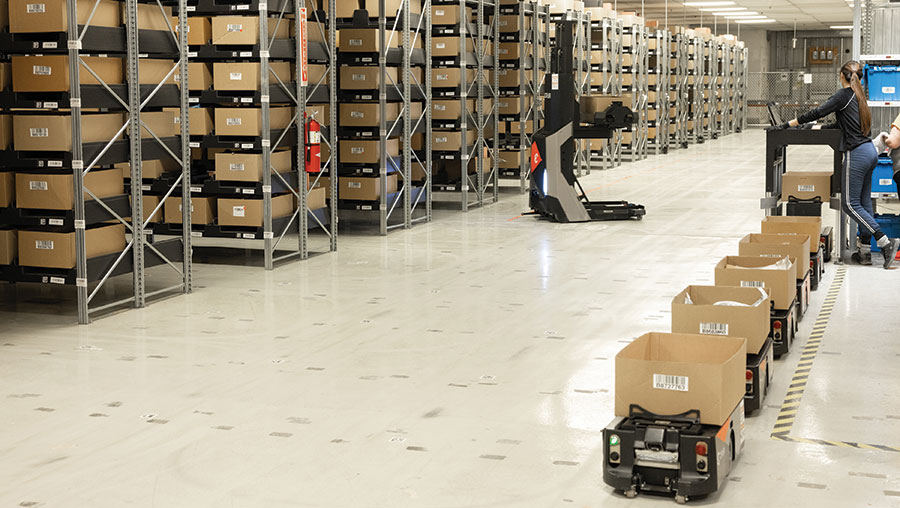
Robots are queued to deliver cartons to be picked to the workstation. After, they will be returned to storage.
Flexible automation
Robotics was the next step in the flexible automation evolution. The search led Bergen Logistics to Caja Robotics a little over three years ago through a business associate of Ron Roman’s. At the time, Bergen Logistics was actively investigating a variety of automated solutions.
“It was getting difficult to find and keep labor,” says Eli Roman. “We believed that trend would continue, even before Covid, and we knew we were going to need more automation in the future.”
The solution not only needed to reduce the labor requirements associated with order fulfillment, including picking and replenishment of pick modules, but also meet targets for the number of boxes delivered to a set number of pick stations during a shift. The labor freed up by automation could then be redeployed to other areas of the facility where automation wasn’t realistic.
Over the next year or so, they considered shuttle systems and other automated goods-to-person technologies along with several different autonomous mobile robotic solutions. Shuttles and mini-loads required too much fixed infrastructure that might not adapt to new customers down the road. Other AMRs didn’t provide the right labor-to-throughput ratio or couldn’t with storage units that were 15-feet high.
The solution chosen checked the most boxes on the requirement list. For one, it provided automated storage and retrieval, like a shuttle or mini-load system, but without a fixed infrastructure. Instead, palletized bins are delivered to a work area where associates scan them into a staging unit, much like a putwall for storage bins.
There, they are retrieved by the larger of the two units, which puts the bins away into storage in a shelving area. The robots can put bins away at 15 feet, which was higher than other solutions on the market, and can accommodate a variety of bin sizes.
The larger storage and retrieval units reduced the number of associates required to replenish the picking module. The smaller units that deliver bins to the goods-to-person picking stations further reduce the number of associates required for picking. In this configuration, the smaller robots queue in front of the goods-to-person stations while associates scan picked items into totes in a putwall area that can handle 30 orders at a time—some totes are designated for single line orders.
Finally, the system can be easily expanded as customer needs and processes change. “We can add extra robots if we get a spike in demand; we can expand the system with more shelving units and we can move everything to another floor or another building if we need to,” says Ron Roman. He adds that Bergen Logistics is in the process of expanding the number of shelving units and fleet size.
Going live
According to Eli Roman, the project took about 18 months from pilot to go live. The initial pilot began with two of the larger lift robots for storage and retrieval and five small robots to deliver to goods-to-person workstations. During that time, they made operational changes.
“About six months into the pilot, we realized we needed to increase the speed of the system to get the right amount of throughput,” he recalls. The solution provider was able to increase the speed from 0.8 to 1.2 meters per second. To accommodate the higher speed, two pieces of metal were installed in front to prevent the robots from tipping over if they made a sudden stop in an emergency situation.
A second was a redesign to reduce the time required to swap out the batteries of the larger robots.
Finally, Bergen Logistics created a fast-pick area to handle bins that were in heavy demand.
While there were concerns about whether associates would accept robotics, Eli Roman says that turned out not to be an issue. “The team that works with the robots is technically savvy,” he says. “They adapted very quickly and enjoy working with the robots.”
At the time of this writing, the system includes the five large storage and retrieval units, 20 delivery units and two pick stations. There are 32,000 bin locations in a 25,000-square-foot area. The expansion currently underway will double the storage space and increase the fleet size. Bergen Logistics is also in the process of deploying a lease arrangement that will allow the 3PL to add equipment on a short-term basis to handle peak seasons, much the way companies use short-term rentals and leases to add lift trucks during peak.
Last, Ickes notes that the 3PL continues to tweak how it operates the system. For instance, Caja Robotics has made further increases to the speed of the robots, which will reduce the size of the fleet in the expanded space. And Bergen Logistics is expanding the products that can be handled in the system by, for instance, putting dividers in bins to handle small products like jewelry. “We’re learning to leverage the system to handle more products, which will increase our ROI,” Ickes says. “And, as the cost of these systems falls, we’ll have a competitive advantage on price and the service we can offer our customers.
Get an in depth look at the Bergen Logistics fulfillment solution here.

Article Topics
Automation News & Resources
Beckhoff USA opens new office in Austin, Texas ASME Foundation wins grant for technical workforce development Walmart chooses Swisslog AS/RS and software for third milk processing facility Lucas Watson appointed CSO for Körber’s Parcel Logistics business in North America Kathleen Phelps to join FORTNA as chief financial officer Coles automates grocery distribution in Australia 2024 Intralogistics Robotics Survey: Robot demand surges More AutomationLatest in Materials Handling
Geek+ and System Teknik deploy PopPick solution for pharmacy group Med24.dk Beckhoff USA opens new office in Austin, Texas Manhattan Associates selects TeamViewer as partner for warehouse vision picking ASME Foundation wins grant for technical workforce development The (Not So) Secret Weapons: How Key Cabinets and Asset Management Lockers Are Changing Supply Chain Operations MODEX C-Suite Interview with Harold Vanasse: The perfect blend of automation and sustainability Consultant and industry leader John M. Hill passes on at age 86 More Materials HandlingAbout the Author
Subscribe to Materials Handling Magazine

Find out what the world's most innovative companies are doing to improve productivity in their plants and distribution centers.
Start your FREE subscription today.
April 2024 Modern Materials Handling

Latest Resources


